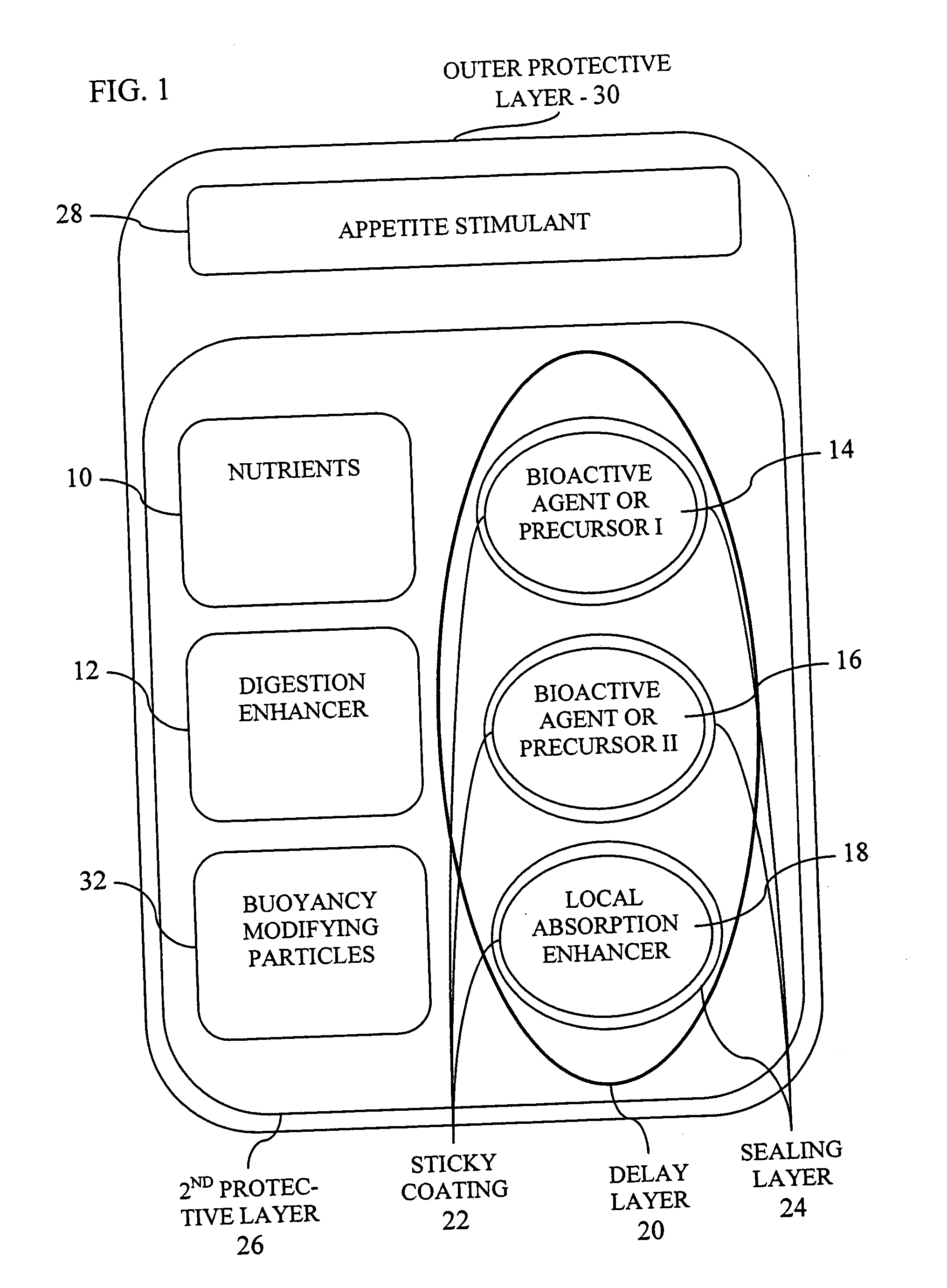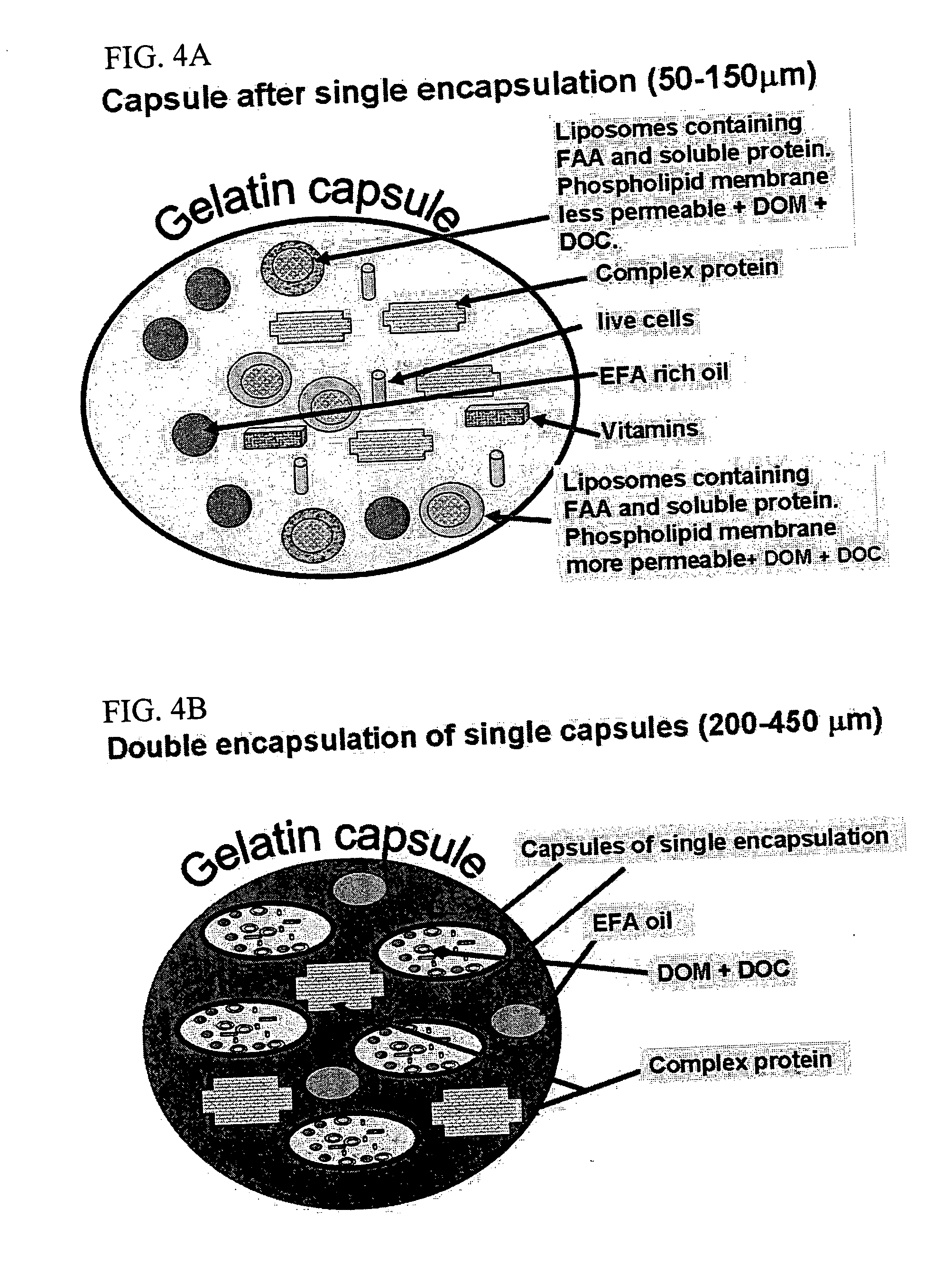Food formulation for aquatic animals with integrated targeted delivery of bioactive agents
a bioactive agent and food formulation technology, applied in the field of aquaculture, can solve the problems of affecting the development of fish farming industry, affecting the absorption of bioactive agents, and affecting the absorption rate of bioactive agents, so as to improve the absorption rate, enhance digestion, and enhance the proximity of the release of bioactive agent precursors.
- Summary
- Abstract
- Description
- Claims
- Application Information
AI Technical Summary
Benefits of technology
Problems solved by technology
Method used
Image
Examples
examples
[0081] The following examples are provided by way of illustration but should not be considered in any way to limit the present invention.
[0082] According to a first preferred example, the invention is implemented with an outer gelatin capsule (200-450 μm) which is stable in neutral freshwater or seawater. In one example, the product was encapsulated in a matrix of gelatin and Acacia gum which allows the formulation of soft and buoyant capsules that are acceptable to larvae. In addition by using various gelatins that dissolve at different levels of pH, the capsule can release its contents in different regions of the digestive tract which have a characteristic pH. This allows the optimization of the capsule for a given aquatic species and developmental stage. In addition, double encapsulation is used to arrive at optimal size and superior buoyancy characteristics and to increase the size of the capsules, thereby rendering them appropriate for feeding fish larvae.
[0083] The outer gel...
experiment i
imilation of Nutrients
[0085] The enhancement of assimilation of nutrients is illustrated in the following experiment, applied to twenty-two glass beakers in a flow through, aerated experimental system, stocked with 50 gilthead seabream larvae, 26 days after hatch per beaker. Two radioactive microdiets (MDs) were produced; where their neutral lipid fraction included equal amounts of 14C glycerol trioleate (triacylglycerol) and were identical in levels of protein, lipid, carbohydrate, vitamins, and minerals. However, the two MDs differed in that their liposome component contained either distilled water in the control, or selected aliphatic and aromatic FAA (in this case: valine, leucine, and isoleucine, tryptophan, phenylalanine in the ratio 1:1:1:1:2). Phenylalanine was included at twice the level of the other FAA as this FAA is believed to particularly stimulate CCK secretion, although the specific ratio used was not necessarily optimized. A third treatment, was tested as the radioa...
experiment ii
for Enhanced Localized Delivery
[0087] A further preferred aspect of the present invention is demonstrated in the following example whereby electrical surface charge is used as a docking tool to bring liposomes (carrying drugs, vaccines, etc.) into the vicinity of the epithelium of the fish intestine.
[0088] Adhesion of neutral and cationic liposomes to the gastric mucosa of adult gilthead seabream (Sparus aurata) is illustrated in the following experiment carried out by the inventors. Two radioactive and one non-radioactive batch of liposomes were prepared: a) a 140 mg batch of neutrally charged liposomes was produced by first adding 10 μCi of 14C-free stearic acid to hydrogenated phosphatidylcholine (PC) and cholesterol (CHOL) at a ratio of 10:4 (w / w). A lipid film of these components was produced followed by agitation and hydration with 7 ml of Ringer solution, which produced multilamellar lipid vesicles (MLV). The MLVs were then extruded through a 0.6 μm filter to produce single ...
PUM
 Login to View More
Login to View More Abstract
Description
Claims
Application Information
 Login to View More
Login to View More - R&D
- Intellectual Property
- Life Sciences
- Materials
- Tech Scout
- Unparalleled Data Quality
- Higher Quality Content
- 60% Fewer Hallucinations
Browse by: Latest US Patents, China's latest patents, Technical Efficacy Thesaurus, Application Domain, Technology Topic, Popular Technical Reports.
© 2025 PatSnap. All rights reserved.Legal|Privacy policy|Modern Slavery Act Transparency Statement|Sitemap|About US| Contact US: help@patsnap.com



